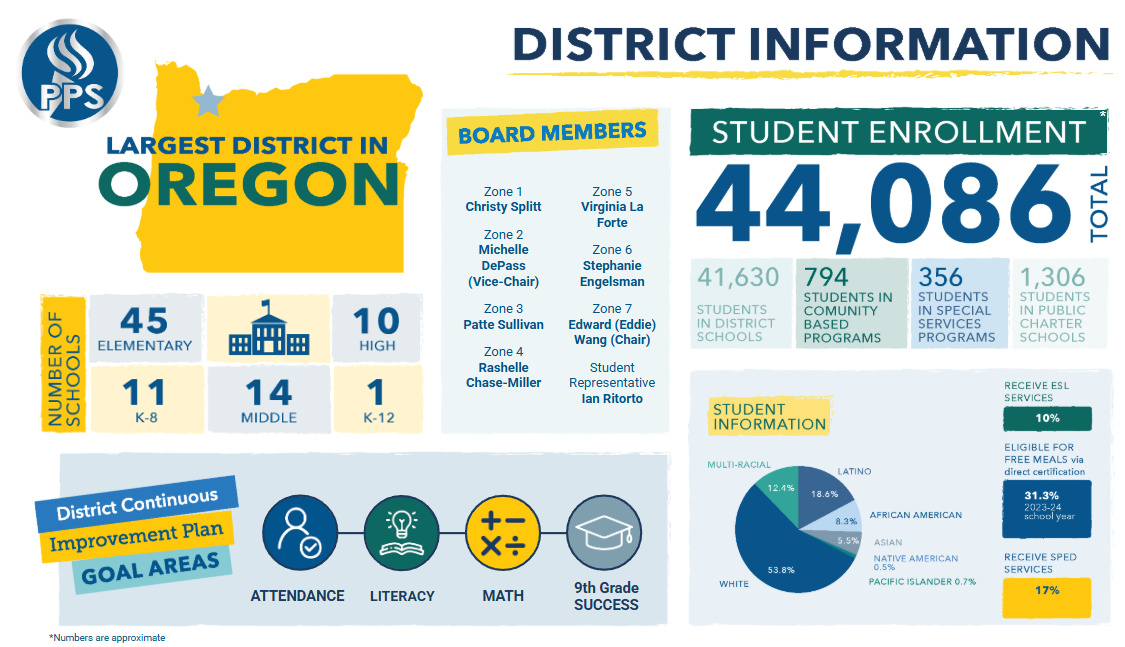Disclaimer: The author of this article is a student enrolled in Franklin’s Chinese program.
Due to the $30 million in budget cuts implemented by Portland Public Schools (PPS), Franklin administration had to make hard decisions on what and who to let go of. Mo Wang — Franklin’s only Chinese teacher — was on maternity leave when she was told her full-time teaching position was going to be cut to half-time beginning in the 2024-25 school year. The effects of this decision will reach far beyond academic boundaries, negatively affecting many of Franklin’s underrepresented students.
Wang has been teaching Mandarin Chinese at Franklin for nine years, instructing all Chinese classes from levels 1-2 to Advanced Placement (AP), and she proudly runs the only AP Chinese Language and Culture program in the entire PPS district. Not only does Wang run an entire Chinese language program, she also acts as a cultural liaison for many Asian students at Franklin. The decision “will have a negative impact on providing a consistent, high-quality, and joyful Chinese learning experience and cultural exploration across the school,” says Wang.
“I chose Franklin because I was attracted by this Chinese program,” says Chenxi Li, a junior and current AP Chinese student who is alarmed at this decision. “What if other people are experiencing the same [disappointment]?”
The decision will cut access to time, resources, and upper-level Chinese classes like Chinese 5-6 and 7-8. If this decision is carried through, there will be no AP Chinese. Since Franklin is the only school in the entire PPS district to offer AP Chinese, this is a tremendous loss.
The decision to cut Wang’s teaching position to half-time was based on the most recent forecasting numbers. Dr. Zulema Naegele, Franklin’s principal, explains that “the biggest piece of information used by principals [in course and staffing decisions] was the forecasting information.” Naegele says that “not only did we look at the numbers based on this year, but also previous years. So we looked at the pattern of how many students were taking Chinese.”
This year, forecasting numbers for Chinese were particularly low, resulting in Wang’s reduced teaching time. However, upon examining the forecasting numbers with my own eyes, something seemed off.
According to the most recent forecasting numbers, only four people forecasted for Chinese 7-8. However, 28 people forecasted for Chinese 3-4, and 11 students forecasted for Chinese 1-2. Numbers for German were also low, with 33 incoming freshmen — in comparison to 152 incoming students for Spanish — and one lone forecaster for German 3-4. For Russian, the maximum number was 13 people forecasting for Russian Immersion 1-2. It surprised me that Russian experienced no staffing change despite the meager forecasting numbers. But Naegele explains that “because it is part of our immersion program, there is extra funding that comes from the district to fund that particular program.” Chinese simply does not get the funding needed. If it was prioritized like the Russian Immersion program, forecasting might not have played as big of a role in this decision.
Where there is funding, there is a way. The question is how we can maintain the Chinese program to acceptable standards without this backbone of support. It cannot be overlooked that the Chinese program, the most threatened, happens to also be the only non-European language program. Even if unintentional, the Franklin administration is complicit in the prioritization of Eurocentric educational trends by not actively trying to support existing non-European programs.
Where funds are allocated speaks for the values that leaders hold. The Franklin administration’s choice reduces access to a program that has continuously served underrepresented students in the past. One might assume that the Chinese language program solely benefits non-native Chinese speakers, but that is not the case here at Franklin. The Chinese program itself is a highly culturally diverse community. If you were to step into my AP Chinese class, you would find students who are native Chinese speakers who moved to the U.S in the past few years, American-born Chinese students, and non-native speakers who have developed advanced language skills.
The Chinese program being such a diverse community, it naturally serves many purposes. Tina Wang, a current junior and AP Chinese student, appreciates this unique learning environment. “I like how there’s some people who are fluent in Chinese, so they can help me. And then I can also help them with their English. [For the students] that aren’t as fluent in Chinese, I can also help them with the Chinese language.”
Wang’s affinity for Chinese dramas and desire to connect more with her family led her to study Chinese at Franklin. “I identify as Chinese American, and I was born here in America, but my parents are Chinese,” explains Wang. “ [I also took Chinese] to communicate more with my grandparents because they only spoke Chinese.”
Mo Wang is essential for creating this open and supportive environment. “I serve the Asian student community, particularly new immigrant students, by providing a safe and comfortable space for them. I teach them essential life and study skills, build relationships with their families, and help them integrate into our community.” In this way, Franklin’s Chinese program facilitates not just academic learning, but also cultural and social resources for Asian students. To downsize the Chinese program is to minimize the capacity for supporting underrepresented Asian students, something forecasting numbers can’t account for.
A Chinese program serves all of the Franklin community. As Li points out, “Our school has a rich resource in providing us this Chinese [program].” Chinese, being one of the most widely spoken languages globally, holds significance in our increasingly interconnected world. Li recommends taking Chinese because you can “have so many job opportunities, travel to [Chinese speaking countries], and learn another new language.” Furthermore, Mo Wang asserts that the Chinese program “values culturally responsive instruction that extends beyond Franklin out to the families and community.” This program is a way for Franklin students to form cross-cultural connections and broaden their worldviews. It is not just to learn about other cultures, but also to enrich our own culture here at Franklin.
There is still time to push back against this decision. In order to protect our Chinese program, we can do two things. First, we must put pressure on the administration to reconsider cutting Wang’s time. Secondly, Franklin students must continue to forecast for Chinese so that upper-level Chinese classes may be available in the future. If there aren’t sufficient forecasting numbers for lower-level classes, the whole program will be shut down. It’s time to urge our administration to demonstrate their appreciation for underrepresented groups through their actions.



































Madeline • May 26, 2024 at 2:30 pm
Thank you for this story, though it saddens me to read. This has been such a great language program at Franklin. I’m the parent of a student who had 4 yrs of Chinese at Franklin with Ms. Mi. She went on to have double majors in college of Chinese and International Relations, and continues to use her language skills professionally in her career. I will contact FHS admin and let them know this is a shortsighted mistake.
Lucy • May 22, 2024 at 10:18 pm
As a Franklin Chinese program alum, it breaks my heart to see the program losing its support. Wonderful article on the importance of cross-cultural exposure in our community.
Frankie • May 22, 2024 at 4:57 pm
Such a powerful article!